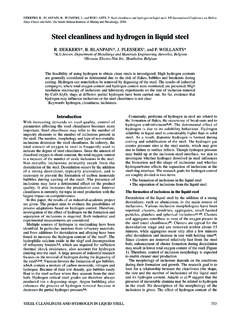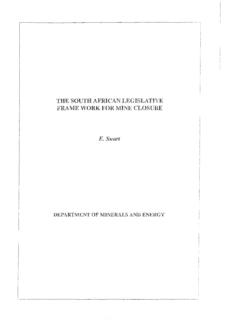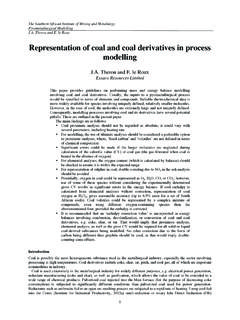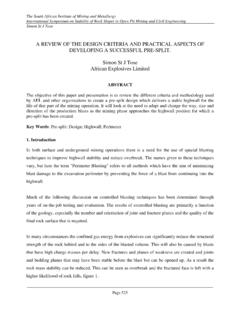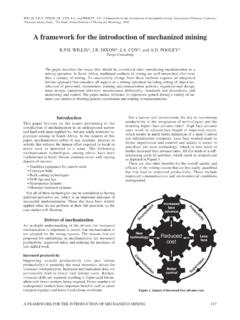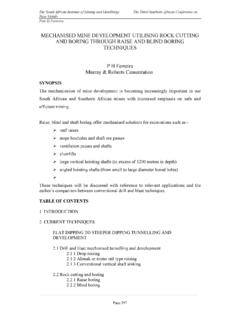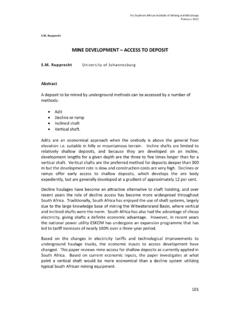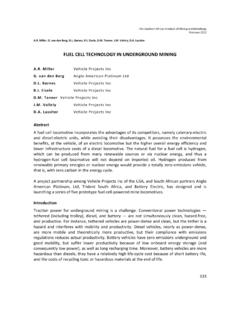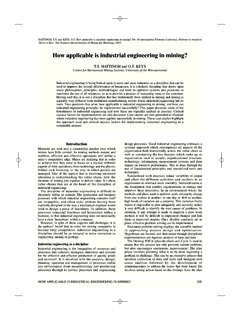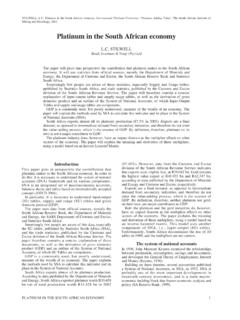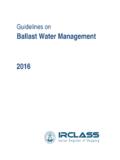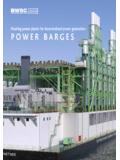Transcription of Retreatment of Residues and Waste Rock - SAIMM
1 Chapter 12 Retreatment of Residues and Waste Rock Bosch Introduction From the commencement of gold mining on the Witwatersrand in 1887 up to 1984, a total of approximately 4,2 billion tons of gold ore has been milled in South Africa. The deposition of gold mine Residues has left the country, particularly Johannesburg and its neighbouring cities in the central Witwater-srand, with a legacy which has not only been an eyesore but also a source of irritation and dust pollution in the dry, windy season, and contaminated run-off water in the rainy season. Large amounts of money have been spent combating this pollution and as a result of successful vegetating of their sur-faces, the residue dumps in the Johannesburg area have now become well known as landmarks identifying the Golden City. Extraction of the low grade gold content of the dumps has long been researched by metallurgists and recently a number of developments have com-bined to make the Retreatment of gold Residues a profitable proposition, not the least of which have been.
2 The rise in the rand price of gold; .. modern metallurgical technology leading to more efficient extraction pro-cesses with lower costs; .. the high value of the property which becomes available for further development after removal of the Residues . Origin of Residues Sand dumps and slimes dams Residues contained in sand dumps and in slimes dams consist essentially of three different products, namely separate sand and slime and slime from the all-sliming process. In the early days gold was recovered from stamp-milled material by gravi-ty concentration only. Later, in 1890, the product of stamp milling was split into sand and slime fractions. The sand was treated by percolation cyanida-tion, whereas the slime was accumulated for lack of a suitable treatment process. In 1894 the decantation process for slime treatment was introduced. Both accumulated and current slime were leached. This resulted in two discard products; sand which contained about 11 070 minus 75 j-tm, and slime which contained about 95% minus 75 j-tm fines.
3 Gold values of the material depend-707 THE EXTRACTIVE METALLURGY OF GOLD ed on a number of factors but ranged from 0,3 to 1,5 g/t for sand and 0,05 to 0,50 g/t for slime. Tube mills were introduced in 1904 to grind the stamp mill product fur-ther, and this reduced the ratio of sand to slime. This development was ac-celerated by the introduction of the all-sliming process in 1918. However, sand treatment plants were slow to be phased out and the method persisted for many years. By 1936, 40% of the ore milled was still leached in sand treatment plants. Almost 20 million tons of sand per year was still deposited onto dumps. By 1946 this figure was considerably reduced and in that year only 13% oJ the ore, amounting to some 7,3 million tons, was treated in sand plants. Today tailings from the all-sliming process constitute virtually all the Residues from gold plants. The size range of this material is between 65 and 80070 minus 75 /-tm and typical gold values range from 0,1 to 0,5 g/t.
4 In a few exceptional cases accumulated tailings have values between 0,5 and 1,0 g/t. Gold plant tailings at present amount to a little over 100 million tons per year and this figure is expected to increase in the future. The tendency is to mine lower grades, which will result in lower gold values in Residues . A new development in the industry is the classification of the residue by cycloning and the use of the cyclone underflow for backfilling underground. During cycloning a small degree of upgrading of the gold value occurs in the cyclone underflow and this gold will obviously not be available for recovery at a future date unless treated underground. The cyclone overflow which will be deposited on the slimes dams will be considerably finer than the original residue (>95% minus 75 /-tm) and of a lower grade. The backfilling programme is still in the early stages of development and the amount of residue being placed underground is insignificant. However, it is predicted that most South African gold mines will be using Residues for backfilling within 10 years.
5 The amount of residue which can be used for backfilling is up to 45 % of the tonnage mined. f\-significant reduc-tion in residue tonnage for deposition on slimes dams, as well as a reduction in the gold content of this material, can therefore be expected. Rock dumps Waste rock arises from two main sources, namely underground development and sorting. In both cases the Waste is mineralised to a greater or lesser ex-tent. The values are very heterogeneously distributed amongst the rock pieces and vary so widely in magnitude that the grade of a bulk sample is only mean-ingful if no upgrading is contemplated. Waste rock from off-reef develop-ment can become contaminated during transport to surface by mineralised rock from unpay and marginal areas, from mistakes in tramming and tip-ping and by gold bearing fines with which it may have come into contact. Rock pieces rejected by sorting should only be those mineralised to a lesser extent than the cut-off grade.
6 However, as currently available sorting methods, whether manual or machine, rely on some secondary characteristic of the ore which seldom correlates precisely with gold content, and as machine sorting is carried out on the basis of interrogation of individual particles at 70R Retreatment OF Residues AND Waste ROCK high speed, statistics dictate that there will be sorting errors. Whether the Waste rock comes from development underground or from the reject frac-tions of sorting, it is conveyed to large dumps where it is stockpiled until some use can be justified for it, for instance aggregate preparation for civil engineering works, ballast for railway tracks, rockfill or treatment for gold recovery. By far the largest quantity of material from the Waste rock dumps goes into civil engineering works without prior treatment for gold extrac-tion. This was understandable when gold was $35 per ounce, but disposal in this way needs regular review in the modern climate of fluctuating gold price and currency exchange rates, continuously rising costs and the advent of new technologies.
7 Sampling, Surveying and Valuation When the reclamation of Residues for Retreatment is considered, informa-tion pertaining to the dumps is required in order to carry out feasibility studies that will determine whether a proposed Retreatment programme can be pro-fitable. Part of this information is acquired from the mine surveyors, who would normally be responsible for supplying plans of dumps, dams and sur-rounding areas as well as computing volumes and values of the Residues to be treated. The computation of dump or dam tonnage from volume obviously requires the determination of the in situ bulk density of the material. The plans, compiled by aerial photogrammetric means, provide topographic and cadastral information essential for the planning and layout of the plant and other buildings, pipe lines, conveyor belts, and for the ap-plication for and registration of legal rights such as servitudes, way-leaves, surface rights and dump permits (Section 161 of the Mining Rights Act and Regulations (Act No.))
8 20 of 1967 . A brief description of the sampling, survey-ing and valuation techniques used to obtain the volumes and values of Residues is given below. Sampling A number of sampling methods are employed for the determination of residue values. Time, cost and relevant requirements will dictate the method to be used for anyone set of circumstances. Grab sampling Samples are taken, preferably on an even grid system covering the entire dump or dam surface. Easy access makes this a cost-effective method for the ac-quisition of either small samples for assay purposes or bulk samples for metallurgical testing, especially in a preliminary investigation. There is, however, the danger of the samples not being representative in their response to treatment processes due to surface oxidation. Groove or channel sampling This method is used quite effectively to sample a slimes dam that has been covered by sand or, as is often the case; by building rubble or other refuse, and only the sides of the dam are exposed for sampling.
9 The samples are 709 THE EXTRACTIVE METALLURGY OF GOLD cut from the slime in even, equidistant grooves or channels, on the line of true dip over the entire length of the face slope. Care must be exercised to reduce the measured length of channel sampled to the true vertical depth of the dam. As for grab sampling, the method is useful in providing limited information with reasonable ease. Drilling A uger drilling Little use has been made of auger drilling for sand or slime sampling except with lightweight hand-held augers, where penetration depth is severely limited. Figure Solid auger flight arrangement. The Sandrill A power-driven rig known as the 'Sandrill' is an hydraulically operated auger drill which is extremely mobile and can reach virtually any site. The drill is constructed with an outer casing having removable hardened cutters, within which counter-rotating flights draw the sample up into the sample barrel. Extensions of aluminium tubing are fitted with an inner drive tube on ball bearings.
10 The complete unit weighs approximately 73 kg (Figure ). The rig is capable of penetrating to depths in excess of 90 metres at a drilling rate of between 50 and 300 metres per day, depending on the local condi-tions and the depth from which the sample is being taken (MacDonald, 1983). The Sandrill is the most effective of the sampling methods mentioned. The other techniques, including the hand auger, are limited largely to pro-viding surface information. To obtain relevant data it is necessary to penetrate all parts of a dump or dam and the Sandrill accomplishes this task with reasonable ease at a relatively low cost. However, this method of drilling is not without limitations as the lightweight drill cannot negotiate hard ob-jects such as rocks, wood and scrap iron frequently encountered in dumps and dams. 710 RE TREATMENT OF Residues AND Waste ROCK Figure Core drilling on a Witwatersrand sand dump using a 'Sandrill'. Surveying Surveys of gold residue dams and dumps and surrounding areas are required for: the compilation of accurate working plans; the determination of volumes and tonnages for planning purposes, and the determination of volumes and tonnages for grade predictions and metallurgical comparisons.
